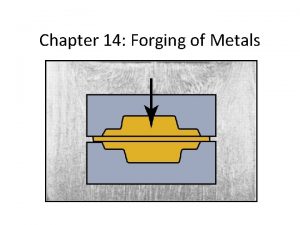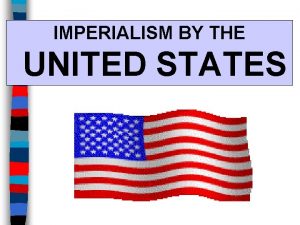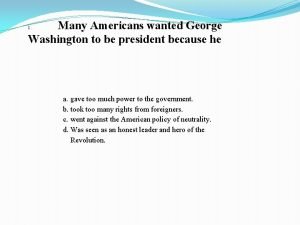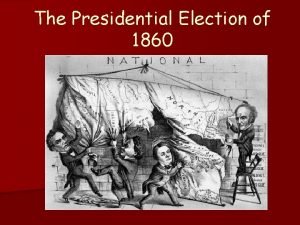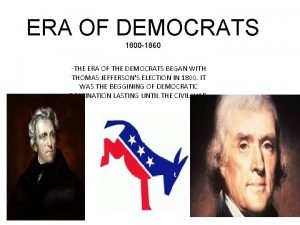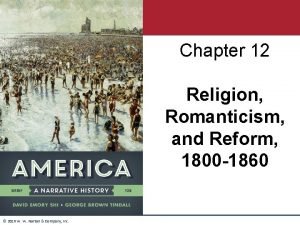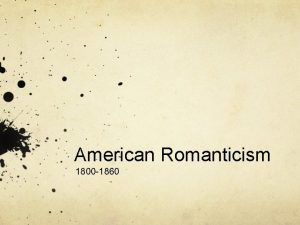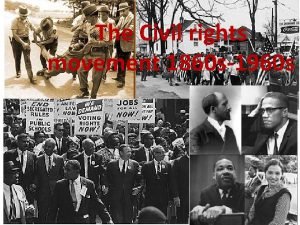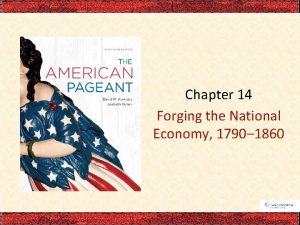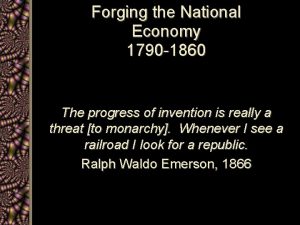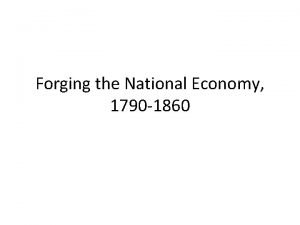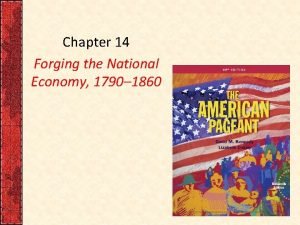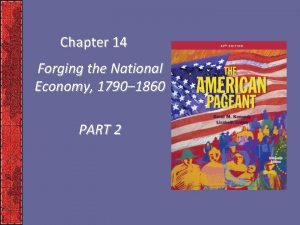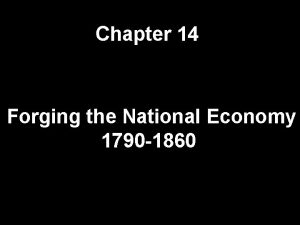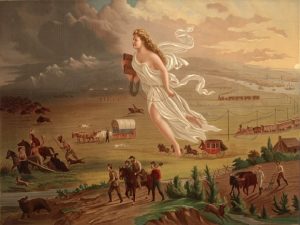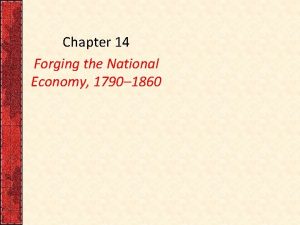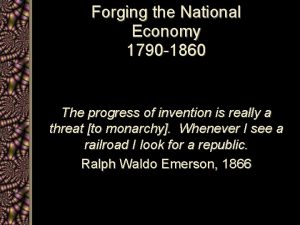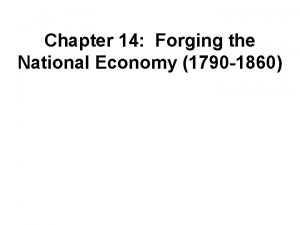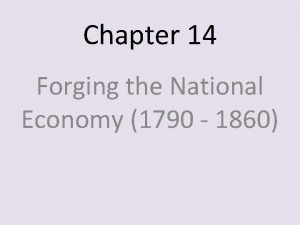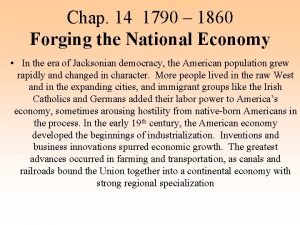Forging the National Economy Market Revolution 1790 1860



















- Slides: 19

Forging the National Economy Market Revolution (1790 – 1860) Learning Target: I will be able to describe the economic changes that took place in the U. S. from 1790 to 1860 and analyze their effects on the nation.

Market Revolution Discussion Questions Evaluate the validity of the term “revolution” used in describing the market changes of the early 19 th Century. Describe the challenges facing the U. S. cotton industry in the late 18 th Century. How did Eli Whitney work to revolutionize both the type of cotton produced and the location of production? Describe the “putting-out” system. How can you connect this system to the eventual system used by Henry Ford in the early 20 th Century? What factors led to the success of the Lowell System and others like it? What role did roads and canals play in the expansion of the U. S. economy and the Market Revolution? Can you connect this shift to any other methods/technologies that have

Shaping the Western Landscape “Europe stretches to the Alleghenies; America lies beyond” Exhausted land led to increased movement west Rendezvous System o Traders from St. Louis met trappers in Rockies Ecological Imperialism o As they moved west, they exhausted all resources to the point of extinction Americans also loved and revered nature o In 1830 s, preservation of nature became a growing movement

March of the Millions By 1860, 13 33 states. People moved west, and reproduction rates were skyrocketing Explosive population growth led to growth of cities o Smelly slums, little policing, impure water, foul sewage, poor garbage disposal Immigrants leaving Europe added to population issues o Freedom from aristocratic caste and state church o Abundant opportunity for land to improve condition o “Low taxes, no compulsory military service, three meals a day” o Steamships increased speed of travel, made it cheaper

Immigration

Emerald Isle Moves West Many Irish leave and come to America because of famine and disease during the mid 1840 s Irish were too poor to move west in America, so they were destined for large cities (Boston and New York City) o Forced to live in slums o Protestant Americans considered the Catholics a social menace o Women became maids, men were used for physical labor o Irish led to wage depression, and were disliked by native workers As time progress, Irish gained position in society o As population grew, became important base politically o Tammany Hall

German Immigration Many Germans immigrated to America as well o Most were uprooted farmers o Many were liberal political refugees, who left because of failed democracy in Germany America benefited greatly politically o Most Germans were liberal in beliefs, opposing slavery and public corruption Unlike Irish, many Germans possessed money and material goods, and therefore pushed westward o Conestoga wagon, Kentucky rifle, Christmas tree o Supported public schools (Kindergarten) Made some enemies o Partied on Sundays o Kept to themselves o Drank “bier” o Led to American support of temperance

Nativist Sentiments Nativist feared immigrants would outnumber, outvote, and overwhelm “Americans” o Immigrants were taking jobs o Immigrants were Roman Catholic, still very unpopular in U. S. Know-Nothing Party o Feared ever-growing Catholic influence o Favored rigid restrictions on immigration and naturalization o Supported fictional literature to defame Catholic church Conflict led to eventual attacks on immigrants and burning of churches America depended on immigrants to survive in the new industrial age

Creeping Mechanization Around 1750, British inventors developed steam powered machines for mass production of textiles America was slow in industrial development o Most Americans cherished land farmed, so labor was scarce until immigration picked up o America didn’t have the capital needed to spur industrialization o U. S. couldn’t produce goods of high quality and cheap price like the British could

Whitney Ends Fiber Famine Samuel Slater is commonly referred as the “Father of the Factory System” o Memorized British textile machines and brought technology to U. S. for spinning cotton thread Cotton picking and refining was very slow, and therefore was expensive Eli Whitney develops the cotton gin in 1793, which revolutionizes cotton and fiber production for the U. S. and world o Cotton became extremely profitable o South became tied to cotton, and slavery increased greatly North and South both prospered

Cotton Gin

Made in the U. S. A. Manufacturing in America was slow until the embargo and the War of 1812. Factories other than those based on textiles started to prosper. o Eli Whitney comes up with the idea of interchangeable parts o Whitney helped both the Northern and Southern causes Elias Howe creates the sewing machine, and Isaac Singer perfects it. Pulled seamstresses from homes to factories. Patents o 1800: 306, 1860: 28, 000

Made in the U. S. A. Technological changes in business led to legal changes as well. o Limited Liability said that in cases of suit or bankruptcy, individuals could only risk as much as their own share. o Lead to formation of corporations. “What hath God wrought? ” o 1844, Samuel Morse runs wire from Washington to Baltimore o Using his telegraph machine, he sends the above message and revolutionizes communication techniques 1851 London’s World Fair o Mc. Cormick’s reaper o Morse’s telegraph o Colt’s firearms o Goodyear’s vulcanized rubber goods

Wage Slaves Industrialization meant a need for a larger labor force, which led to crowding in slums around cities. o Many owners got rich while most workers remained poor o Long hours, low wages, skimpy meals, and unsanitary and unsafe buildings o Was illegal to form labor unions Child Labor o Significant portion of the workforce o Taken out of school, malnourished, and mistreated Improving Lives o Workers gained the right to vote under Jackson o Pushed and won the ten hour work day o Realized strike was efficient bargaining tool, although it was illegal Commonwealth v. Hunt o Ruled that labor unions weren’t illegal conspiracies

Women in the Factories could manufacture goods much faster than women could make them at home, yet hired women o Often worked 12 -14 hour days, six days a week o Were followed off the job, and not allowed to form unions o Offered women greater independence Cult of Domesticity o Glorified duties of women at home Marriages depended more on feelings than arrangement, therefore families were closer knit Families began to shrink Mothers were raising children to be independent thinkers

Field Revolution Western farmers were doing well with shipping to the South, but they wanted opportunity for more profit Looked for ways to gain and farm more land quickly o John Deere and his steel plow o Cyrus Mc. Cormick and his mechanical reaper Turned westerners from subsistence farmers to farmers for profit, or “ambitious capitalists out of humble plowmen” Large scale farming lent itself to trade and commerce in areas other than the South o Transportation was slow though

Highways and Steamboats Early methods of travel were slow and inefficient 1790 s came the Lancaster Turnpike in Pennsylvania o Essentially a toll road 1811 construction began on National Road, or Cumberland Road o Maryland to Illinois, 591 miles o Baltimore to St. Louis Robert Fulton builds the first motorized steamship o Clermont o Made water travel much more efficient o Water travel no longer dependent upon current o Led to increased development along river banks for shipping purposes

Canals and the Iron Horse “Clinton’s Big Ditch” o New Yorkers wanted their own canal to connecting the Hudson River to the Great Lakes for shipping purposes o Erie Canal began in 1817 and was finished in 1825, stretching 363 miles o Shipping and travel became much faster, and land prices near the route skyrocketed Erie Canal showed how quickly technological advancements in transportation could change the face of the national economy. First railroad appears in 1828 o Bad brakes, gauge differences, and times were issues o By 1860, 30, 000 miles of railroad track in U. S. , mostly in North

Cables, Clippers, and Pony Riders 1858, Cyrus Field is first to stretch telegraph cable across Atlantic, from Newfoundland to Ireland o Original cable fails, but permanent one goes in in 1866 Clipper ships made oceanic shipping much more profitable o Smaller ships powered by sail o Extremely quick, but soon replaced by British steamers Pony Express used to quick deliver mail in the West o Overtaken by telegraph
 Barreling in forging
Barreling in forging 1790 foreign policy
1790 foreign policy Imperialism
Imperialism Rocaille meaning
Rocaille meaning Americans wanted george washington to be president because
Americans wanted george washington to be president because Athens and sparta were both
Athens and sparta were both Market leader challenger follower nicher
Market leader challenger follower nicher Positioning segmentation targeting
Positioning segmentation targeting Border states in 1860
Border states in 1860 Balai a tapis 1860
Balai a tapis 1860 Romantic period american literature
Romantic period american literature Election of 1860 definition
Election of 1860 definition Apush 1820 to 1860
Apush 1820 to 1860 Era of the democrats 1800-1860
Era of the democrats 1800-1860 Decreto 1860 de 1994
Decreto 1860 de 1994 Chapter 12 religion romanticism and reform
Chapter 12 religion romanticism and reform American romanticism 1800 to 1860 worksheet answers
American romanticism 1800 to 1860 worksheet answers South carolina 1860
South carolina 1860 1860
1860 American romanticism 1800 to 1860 worksheet answers
American romanticism 1800 to 1860 worksheet answers
